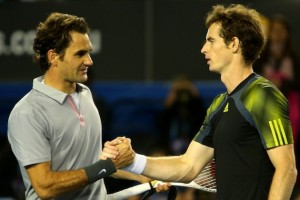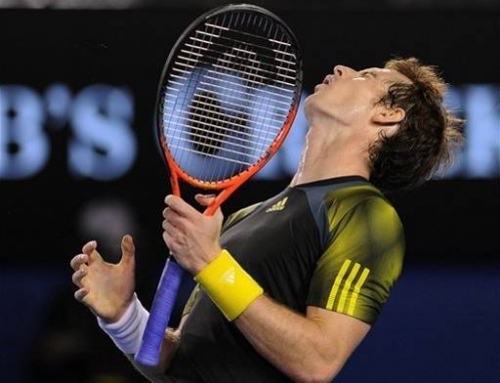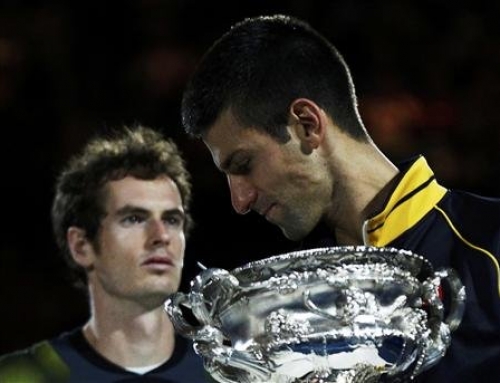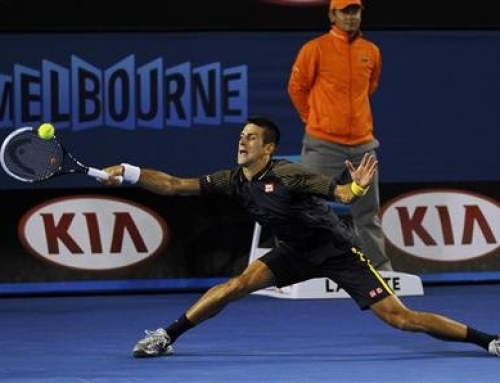 It’s been the monkey on Murray’s back. He can beat Federer, just not at the Slams. Three times they’ve met in the Slams. Three times Murray has been runner-up to Roger Federer.
It’s been the monkey on Murray’s back. He can beat Federer, just not at the Slams. Three times they’ve met in the Slams. Three times Murray has been runner-up to Roger Federer.
Murray lost to him in the US Open final in 2008, then in the Australian Open final in 2010, and finally, in the Wimbledon final in 2012. Of course, this was back in the day when Federer and Djokovic always ended up in the same half of the draw, so the only way Fed and Murray could even meet was in the final. This highly anticipated semi is their first encounter in the semifinal round.
Murray’s quest to win a Slam took a serious upgrade when he hired Ivan Lendl back in late 2011. Lendl has spent 2012 and 2013 trying to overhaul Murray’s game. First order of business was to shorten how long Murray’s matches were lasting. Murray frequently stood meters behind the baseline retrieving shots, using his superior speed to chase balls down, but this often resulted in long matches, especially outside the Slams against inferior opponents. He’d still win, but he’d rarely win easily. Murray’s always known he was fairly passive. Indeed, the press kept accusing him of letting other players overpower him. But tennis players are a stubborn lot. Maybe Federer would return more serves if he stood further back, but much like Agassi, he prefers to stand in very close.
Lendl convinced Murray that he needs to prefer losing playing an offensive game than winning playing pure defense.
For 2013, the new goal is getting Andy Murray’s first serve percentage up. For years, Murray preferred to thump in first serves even though it meant he got them in only a little above 50% of the time. This is pretty incredible considering how tall Murray is. Players like Roddick and Federer, shorter by a few inches, got their serves in more often. Murray is using a bit more slice, and varying up his serves more to keep the percentage up.
Against Federer, Murray had several things he wanted to do. First, win free points off his serve. This he did just fine. 21 aces to Federer’s 5. Federer may be a good spot server, but his serve rarely goes above 130 mph while Murray’s frequently reaches this mark. Add to that, Murray is a better returner and Federer is a worse returner, and you get Murray holding serve well.
The first set was tight for both players who felt some opening set jitters. Murray seemed to read the Federer serve well, with most serves, first or second, coming back. Murray had several games where he had chances to break, but only broke once. Murray himself had one game where he had to save break point, but otherwise was serving well. Murray’s strategy was to play the Federer backhand, but do so without hitting deep angles. Federer seemed content to trade rallies with his steadier backhand, but it wasn’t enough to overcome Murray. When Federer would go down the line with his backhand, Murray would hook a forehand into the open court. Murray was also looking to hit hard inside-in shots to Federer’s forehand which Federer struggled with (that is, moving quickly to his right to hit the inside-in shot by Murray).
In the second set, Murray struggled more with returning Federer’s serve, but then Murray also continued to serve well himself. These are the kinds of situations that Federer enjoys where the winner of a set wins by a few key points, like he did against Raonic or Tsonga. This set went to a tiebreak, which was very close when Federer hit a lob of sorts that was flying long, but Murray spiked it awkwardly, and Federer hit a great backhand to pass him, and eventually claim the second set.
At that point, Federer was hoping to intimidate Murray by attacking returns and being ultra-aggressive. In the past, this has worked as Murray would tense up. But Murray was up to the challenge, and continued to plug away. Murray eventually got into one of Federer’s serve and broke, much to Federer’s chagrin.
In the fourth set, Federer broke early to 4-2 but was broken back. Murray then broke to 6-5, but Federer had an aggressive game to break back. This lead to a tiebreak which Federer got ahead early on and claimed.
This looked like a good chance for Federer to get ahead, but he was starting to lag a bit in some of the rallies, and winning the fourth set seemed to take a bit out of Federer. Much like the US Open finals last year, Murray managed to play strong and get an early break in the fifth, forcing Federer to play from behind. Federer struggled a bit more to stay in rallies. The entire week, Federer has been wearing a shirt underneath. Martina Navratilova commented that she started feeling the cold more as she got older, and certainly, 42 year old Kimiko Date, attributed her loss in the third round to feeling cold. Federer also had to be thinking that even if he came back, would he have any more energy to beat Djokovic. As Murray stretch the lead to 5-2, Fed made some mistakes on his own serve, and Murray broke a second time.
Murray’s new attitude, to take stock of what’s going positive, may have helped that fifth set (Nadal said something similar when he won the epic fifth set of the 2008 Wimbledon).
Federer, in an interview after the fact, said that Djokovic had to be favored, having the shorter match, being two time defending champ, the number 1 player, and of course, recently beating Murray and Murray having one day less rest, and a five-setter. Murray certainly has his work cut out for him.






![[Aussie Open Final] Can Andy Murray beat Novak Djokovic?](https://www.essentialtennis.com/wp-content/uploads/2013/01/20130126andy-500x383.jpg)
![[Day 13, Aussie Open] Bryan brothers win 13th Slam with Aussie doubles title, Kyrgios wins boys title](https://www.essentialtennis.com/wp-content/uploads/2013/01/20130125bryan-500x383.jpg)